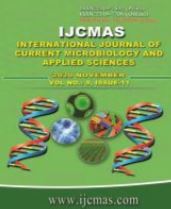


 National Academy of Agricultural Sciences (NAAS)
National Academy of Agricultural Sciences (NAAS)

|
PRINT ISSN : 2319-7692
Online ISSN : 2319-7706 Issues : 12 per year Publisher : Excellent Publishers Email : editorijcmas@gmail.com / submit@ijcmas.com Editor-in-chief: Dr.M.Prakash Index Copernicus ICV 2018: 95.39 NAAS RATING 2020: 5.38 |
A field experiment was conducted to study the changes in mineral status of moringa leaves after heading back and pinching treatments. Three heading back treatments and three pinching treatments were imposed on the moringa trees. The intensity of heading back and time of pruning is crucial for the stability of the tree, proper light penetration and nutrient uptake. Less intensive heading back at 70 cm above the ground level is beneficial in the uptake of N, P, Ca and Mg. Early pruning at 60 days after heading back increased the uptake of mobile nutrients P, K and Mg while pruning at 80 days after heading back influenced the N uptake and late pruning at 100 days after heading back stimulated the higher accumulation of Ca in moringa leaves. In the interaction effect also heading back 70 cm with pinching at 60 days is beneficial to increase the mineral content (N, P, K, Mg) of annual moringa leaves except for calcium that prefers late pruning at100 days after heading back.
 |
 |
 |
 |
 |